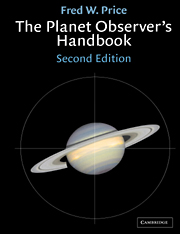Book contents
- Frontmatter
- Contents
- Foreword
- Preface
- Acknowledgements
- Abbreviations used in this book
- Introduction: Why observe the planets?
- 1 The Solar System
- 2 The celestial sphere
- 3 Telescopes and accessories
- 4 The atmosphere and seeing
- 5 Mercury
- 6 Venus
- 7 Mars
- 8 The minor planets (asteroids)
- 9 Jupiter
- 10 Saturn
- 11 Uranus
- 12 Neptune
- 13 Pluto
- 14 Constructing maps and planispheres
- 15 Planetary photography and videography
- 16 Photoelectric photometry of the minor planets, planets and their satellites
- Appendix: Milestones in Solar System exploration
- Name index
- Subject index
14 - Constructing maps and planispheres
Published online by Cambridge University Press: 05 August 2012
- Frontmatter
- Contents
- Foreword
- Preface
- Acknowledgements
- Abbreviations used in this book
- Introduction: Why observe the planets?
- 1 The Solar System
- 2 The celestial sphere
- 3 Telescopes and accessories
- 4 The atmosphere and seeing
- 5 Mercury
- 6 Venus
- 7 Mars
- 8 The minor planets (asteroids)
- 9 Jupiter
- 10 Saturn
- 11 Uranus
- 12 Neptune
- 13 Pluto
- 14 Constructing maps and planispheres
- 15 Planetary photography and videography
- 16 Photoelectric photometry of the minor planets, planets and their satellites
- Appendix: Milestones in Solar System exploration
- Name index
- Subject index
Summary
General
Provided that you have sufficient observational drawings of a planet that comprise one complete axial rotation, you can combine them all into a map or planisphere. Mars is especially suitable for this because of its well-marked surface features. Maps of Mercury have been constructed by several amateurs. Jupiter is also well suited because of its prominent atmospheric features, some of which are fairly permanent.
With some, Mars and Mercury for example, the surface features may take months or even years to gather whereas with Jupiter a complete axial rotation of 10 hours may be charted in a single night when the planet is at or near to opposition.
When making a chart of a planetary surface we are faced with the same problem as with making terrestrial maps – the representation of a curved spherical surface on a flat sheet of paper. The more of the planetary or terrestrial surface that is charted the greater the difficulty of rendering a distortion-free picture – or at least of minimising distortion. Various projections have therefore been devised to achieve the representation of the surface of a planetary or the terrestrial globe on a flat sheet as accurately as possible, all of which have advantages and disadvantages,
The horizontal orthographic projection
The horizontal orthographic projection is the one usually employed in making planetary maps.
- Type
- Chapter
- Information
- The Planet Observer's Handbook , pp. 377 - 382Publisher: Cambridge University PressPrint publication year: 2000



